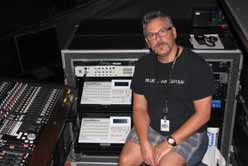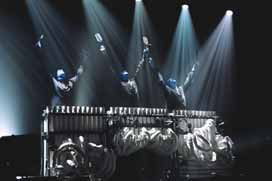With its striking multimedia images, vaudeville-inspired stage antics, and primal drumming rhythms, Blue Man Group is a one-of-a-kind entertainment phenomenon. An estimated 17 million people worldwide have seen Blue Man Group performances, with productions currently running in New York, Boston, Chicago, Las Vegas, Orlando, Berlin, Oberhausen, Stuttgart and Tokyo. And while the Blue Man Group multimedia performance troupe in Orlando are entertaining audiences on stage, they are backed by performance technology that provides highquality digital sound, automates scenery and lighting, and supplies stunning video imagery.
Two 360 Systems Instant Replay audio players deliver the kind of dependability and ease-of-use that audio supervisor Roger Psutka and audio designer Matt Koenig have come to depend on. “Our Instant Replay2 units are simple to load and operate and they are very, very reliable,” says Psutka, a veteran touring engineer. “We can pretty well just plug and play. They’re also easy to train someone
The Orlando production is not as large as the Blue Man Group’s Las Vegas show, but has automated scenery and a bigger set than the New York, Boston or Chicago productions. on.”
He has three units on hand at the Sharp AQUOS Theatre at Universal Orlando Resort, a permanent installation where the troupe began performing last year. One unit is the primary player and the other is a back up, but sometimes both are used in the show. The third unit is a spare. Three units are also used for the touring show. The IR2’s handle everything from original sound effects and music to custom mixes of songs by other performers, such as the KLF.
Real-time audio files are loaded from a PC or CD via the IR2’s Ethernet port. Heads and tails are edited and a show order playlist is built. Both IR2’s are wired into a Yamaha PM1-D digital console, which is used to trigger the playlist. About 12 different files are used in each 90-minute show, some under a second long and some nearly 19 minutes in length. The outro clip that plays when the audience is leaving is usually about 15 minutes of original music.
“We use the IR2’s for playback because they interface well with the Yamaha — it lets us stay in the digital realm,” explains Psutka. “Over my three years of experience with Blue Man Productions, the IR2’s are awesome — simple to load, edit, and operate.”
Psutka says his job is similar to working a rock show, “but you can sit down and run an interactive show that gives you something new to mix each and every time.”
The Orlando production is not as large as the Blue Man Group’s Las Vegas show, but has automated scenery and a bigger set than the New York, Boston, or Chicago productions, according to Paul Ackerman, senior GM/Production, Blue Man Productions. Showman Fabricators, New York, designed and installed the new Stage Automations system, which consists of nine pieces powered by eight Niscom drives and a Raynoc software package.
“There are eight axes of motion on the Orlando stage,” explains Ackerman. “A motif of PVC pipes envelopes the set, including a PVC instrument which is tuned to different notes. The instrument, which is on two different wagons, detaches from the rest of the set and forms on center stage where the performers play it.” An offstage operator controls the movement of all of the scenery pieces.
An MA Lighting grandMA console controls both video and lighting systems. Lighting designer Joel Moritz has incorporated the use of intelligent and conventional lighting, including Altman UV lights to add fluorescent effects. Blue Man has also expanded the use of electroluminescent wire (EL), which looks like flexible neon. EL wire has been used since 2000 in the Group’s Las Vegas show, says Ackerman, but is applied in a different way in Orlando.

The Blue Man Group Productions’ audio supervisor, Roger Psutka, with the two 360 Systems Instant Replays used for the show in Orlando. “The use of EL wire has evolved — we now use it in the performers’ costumes as well as scenery. Like animation, it comes alive on stage.”
The grandMA console also contains the user interface for a Hippotizer media server with a custom software package that controls all of the Orlando show’s video content. The customizations allow for live camera recordings of audience participants to be saved to the server, which are then triggered to the RP screen at the end of the show. Two Panasonic DVX 100A cameras are used onstage and cue into the server — as are an automated E650 PTZ unit from the control booth and a Sony XC555 cigar camera, which is pulled out of the set and operated by the performers.
- Video designer Caryl Glaab has the server output going to a total of two rear projectors and five front projectors. Two Christie LX-120 units illuminate the set, two Panasonic 7700 boxes project out into the audience, another two cover the Stewart Filmscreen main screen, and one projects onto a glass sheet covered with shaving cream used by the performers.










